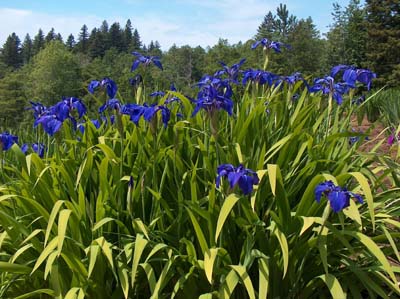Found native to East Asia and Japan. A true water iris, Iris laevigata will look its best growing in shallow water or a large pot with a deep reservoir filled with water. It can also thrive in a moist garden setting if given extra water. All are deciduous.

Planting: Newly received plants that are bare root should be soaked in cool water for a few hours or overnight. Plant the crowns 2-3 inches deep in a prepared bed, 18 to 24 inches apart.
Soil: Prefer a rich soil with ample organic matter. The soil PH should be slightly acid, ideally between 5.5-6.5.
Water: Iris laevigata do not like to dry out. Constant moisture will reward you with healthy plants and larger blooms. Unlike its close cousin, the Iris ensata (Japanese iris), Iris laevigata will grow with its crown under water. Plant in a natural pond at water edge, in a submerged pot, or in a moist garden setting.
Light: Full sun with a minimum of 6 hours to bloom properly. Afternoon shade in hot areas will benefit bloom.
Fertilizer: Depending on your soil a liberal application of a balanced fertilizer for acid-loving plants (Rhododendron, Camellia) in the spring is beneficial.
Mulching (pond): A mulch of pea gravel will help anchor the rhizome and keep the soil from floating away.
Mulching (garden): A mulch of 2 to 4 inches is recommended. This will keep the soil cool, retain moisture, and suppress weeds.
Transplanting: Iris laevigata can be transplanted almost anytime from spring until fall if you keep the plant wet and the temperatures are below 90 degree Ferenheit and above freezing for a month afterwards. Dig and divide your plants every 3-4 years for plant vigor. Plants should be broken down to 2-4 healthy fans, removing the old crowns and roots. Plant 2-3 inches deep in new soils that have been worked up and amended.
Winter Dormancy: Remove and destroy old foliage with a serrated knife after a light frost.
Pests: Slugs and snails; bait if damage is seen. Thrips and iris borer can be controlled with a systemic insecticide (Orthene, Cygon 2E) following manufacturer’s instruction.